MYCO | 1.5 Fungal Spores: Structure, Dormancy, & Dispersal
1/65
There's no tags or description
Looks like no tags are added yet.
Name | Mastery | Learn | Test | Matching | Spaced |
|---|
No study sessions yet.
66 Terms
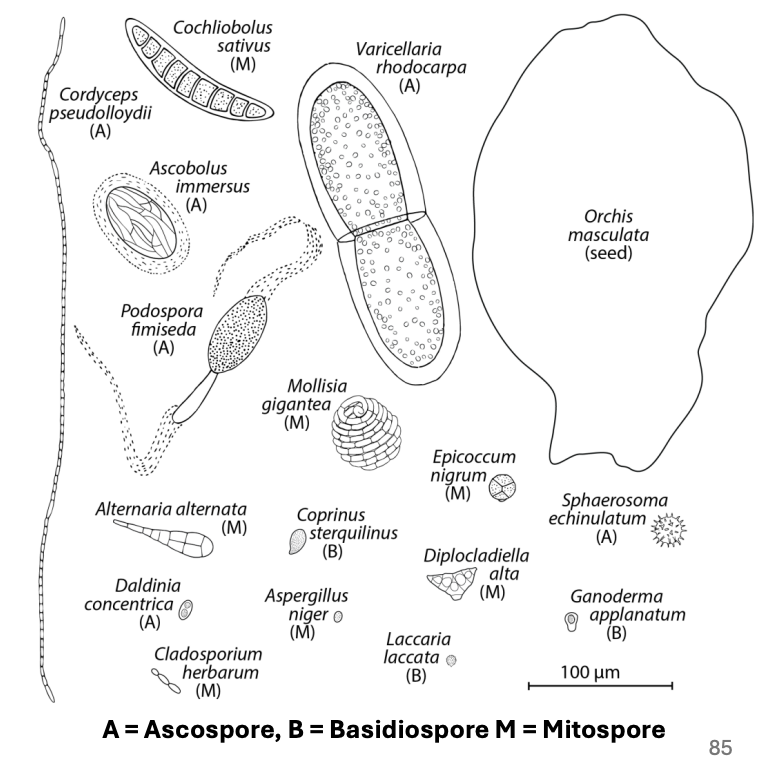
Spores are microscopic propagules of _ that lack an embryo and are specialized for _
great structural and size diversity
dispersal (space) and dormant survival (time)
_ is a cell capable of growing into the same organism as the spore came from
Propagule
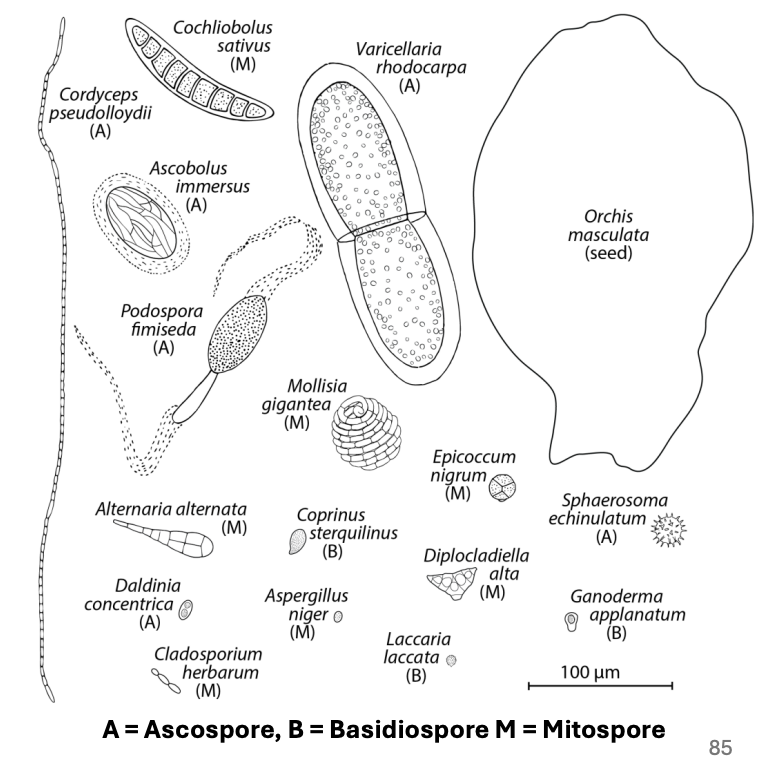
T/F: All fungal spores are unicellular
FALSE
Fungal spores can be uni- or multicellular
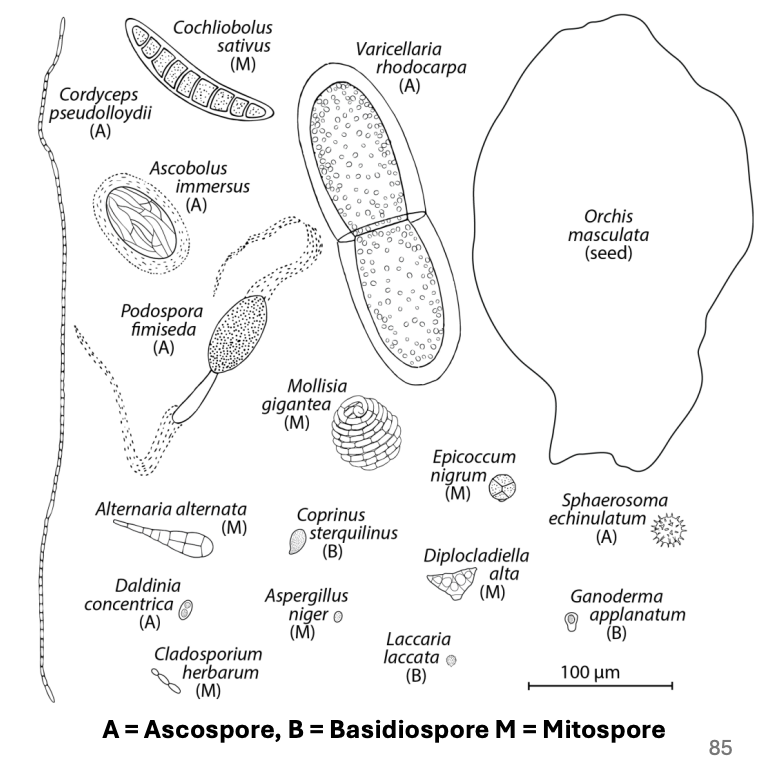
Enumerate functions of spores
Sexually produced spores = dormant survival
Asexual spores (conidia) = dispersal (short- or long-range)
Chlamydospores = specialized thick-walled spores that develop from hypha during nutrient stress
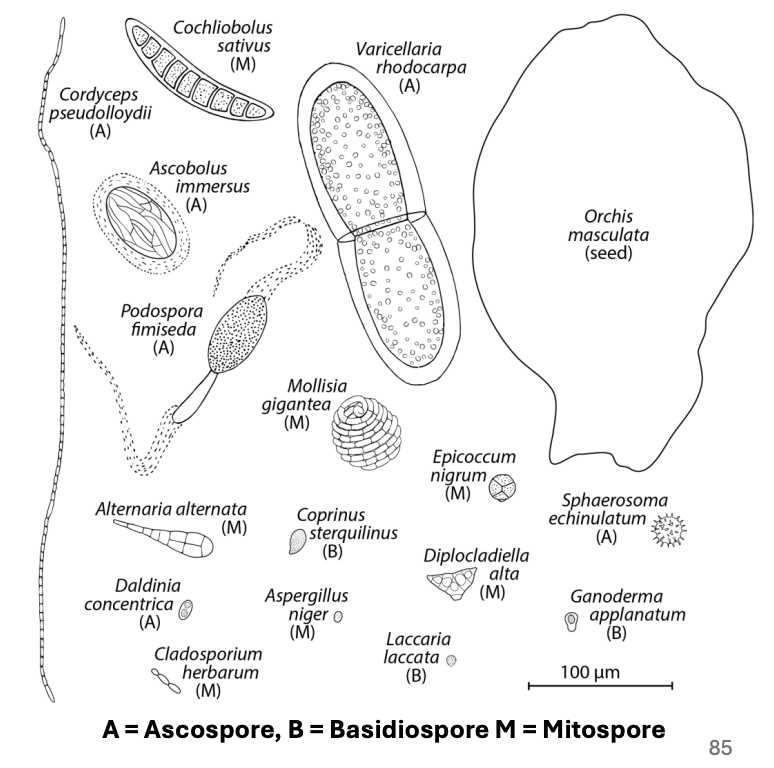
Explain convention for naming spores
Spores are usually named after the division that produced them, e.g., Ascomycota = ascospores; Basidiomycota = basidiospores
Some are named after their origin, e.g., mitospores = produced by mitosis
Enumerate differences between fungal spore vs. average somatic fungal cell
Wall is thicker = additional layers or pigments
Internal structures = cytoplasm is dense, organelles (e.g., ER) are underdeveloped
Mostly ribosomes
Low water content, respiration rate, and production of nucleic acids and proteins (dormant)
High energy storage material = lipids, glycogen, trehalose lgt
Ploidy = asexual spores are haploid
Enumerate common forms of fungal spores + expectations from their design
Sexually-derived multicellular ascospores package meiotically derived nuclei
Appendaged spores allow adhesion to many surfaces
Not just terrestrial but also an aquatic environment adaptation
Controls how fast they’re taken by water
Glass asexual macroconidia use quick methods of short-distance dispersal
Multiple conidia produced in great numbers allow faster colonization of environments
Spore common form
_ package meiotically derived nuclei
Sexually-derived multicellular ascospores
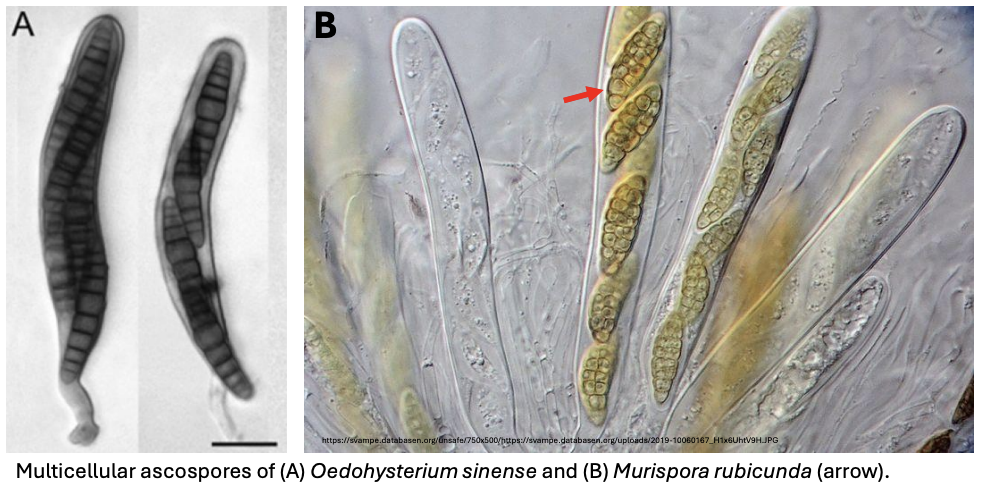
Spore common form
_ are used as quick methods for short-distance dispersal
Glass asexual macroconidia (not actual glass, just transparent hence glass = hyaline)
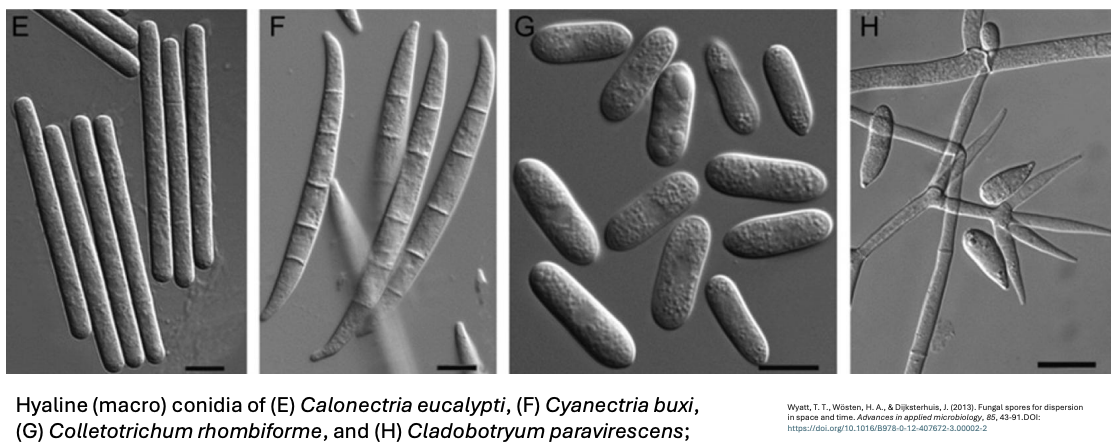
Spore common form
_ allow adhesion to many types of surfaces
Appendaged spores

Spore common form
_ allow fast colonization of environments
Multiple conidia produced in great numbers
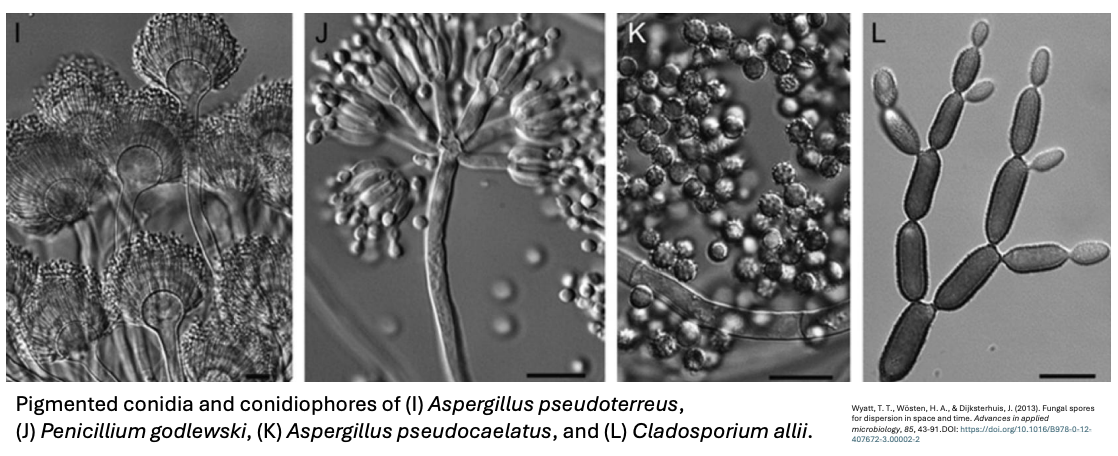
T/F: There is massive diversity of spore structural adaptation to their target environments
TRUE
Enumerate structural variations observed in fungal spores
Caryospora ascospores = 2 beauty blender; colorless septate end cells
Choiromyces ascospores = ragadaga; peg-like ornamentations on spore surface
Curvularia conidia = croissant worm; 4 transverse septa unequal and thus curved; conspicuous basal attachment scar at 1 end
Melanospora ascoposores = lemon-shaped with apical pores at each end
Usually fungi only have 1 pore
Microthyrium = shield-like sporophore called thyrothecium made up several spores fused together
Wind- and water-dispersed
Pestalotiopsis conidia = gummy cola; 3 brown central cells + collapsing colorless appendage cells at end
Testudina ascospores = honeycomb-like surface ornamentation
Thecaphora spores = spore balls w/ cell tetrads that have spiny surface
Thermomyces conidia = Ferrero rocher; coarsely-warted external cell walls
Ustilago single-celled spores = distinct surface-like projections
*Conidia = Curvularia, Pestalotiopsis, Thermomyces
Some fungi produce _ to enhance their survival, e.g., Fusarium oxysporum macroconidia, microconidia, and chlamydospores
multiple types of spores
T/F: Exogenously-imposed dormancy is often found in sexual spores, while constitutive dormancy is often found in asexual spores
FALSE
Exogenously-imposed dormancy is often found in asexual spores (conidia), while constitutive dormancy is often found in sexual spores (ascospores)
In _ dormancy, _ spores would remain dormant in environments unsuitable for growth but would germinate readily in favorable settings
Exogenously-imposed dormancy
Asexual
e.g., Talaromyces atroroseus
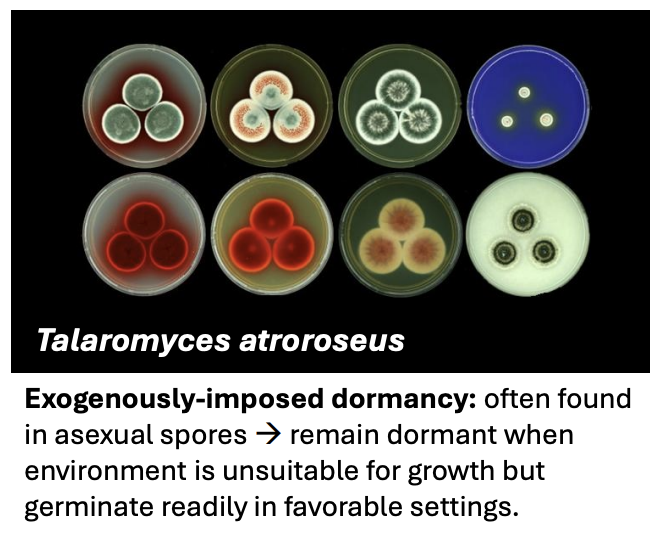
In _ dormancy, _ spores would not germinate readily in favorable settings but would require post-maturation or specific activation trigger
Constitutive
Sexual
e.g., Lyophyllum decastes
3 types of spores produced by Fusarium oxysporum, which is the causative agent of Fusarium wilt disease
Macroconidia, microconidia, chlamydospores
T/F: In some fungi, conidia can develop from fragmented hyphae without needing a conidiophore
TRUE
_ is the primary cause of wilting symptoms in plants infected by Fusarium oxysporum
Blockage of xylem by mycelia
All fungal spores can be classified into two, namely _, based on their germination triggers
Exogenously-imposed dormancy
Constitutive dormancy
T/F: Almost all fungal spores are dormant since their metabolic rate is high
FALSE
Almost all fungal spores are dormant since their metabolic rate is low
All germinating fungal spores follow a _
common pattern of initial development
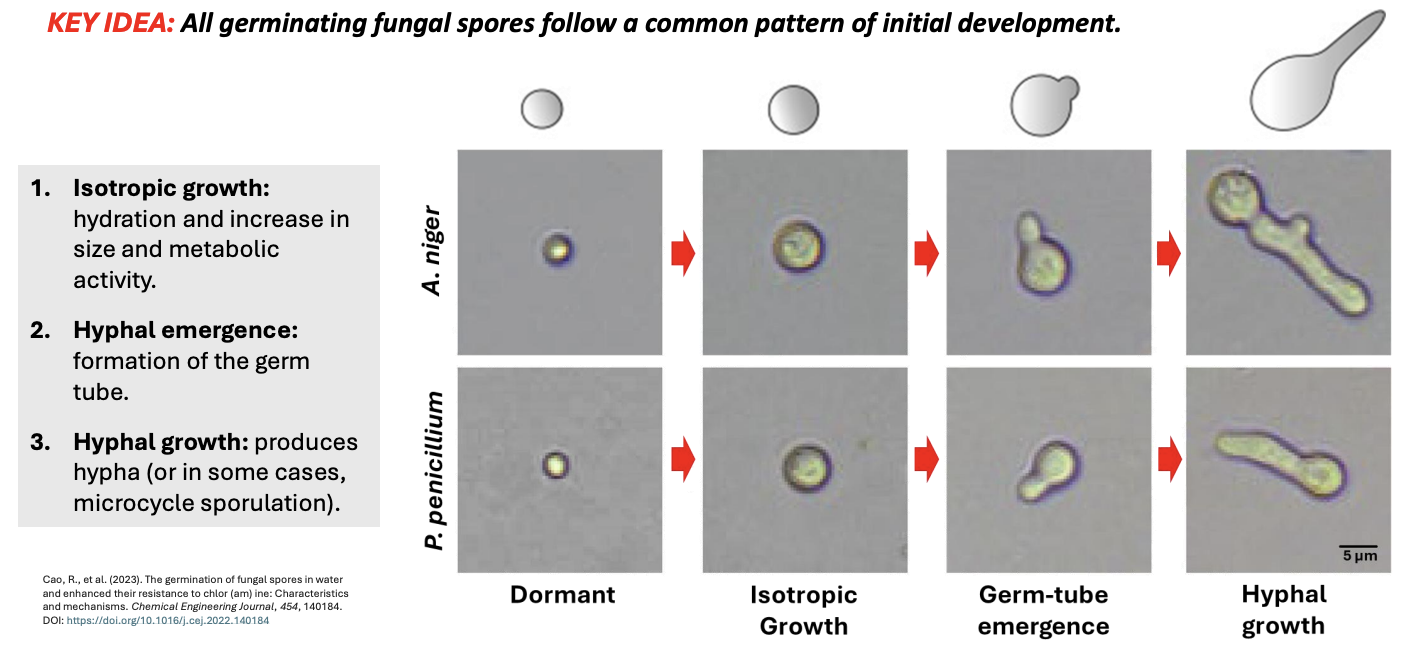
3 basic patterns in initial development of germinating spores
Isotropic growth = hydration, increase in size and metabolic activity
Hyphal emergence = emergence of germ tube
Hyphal growth = produce hyphae, or in some cases, microcycle sporulation
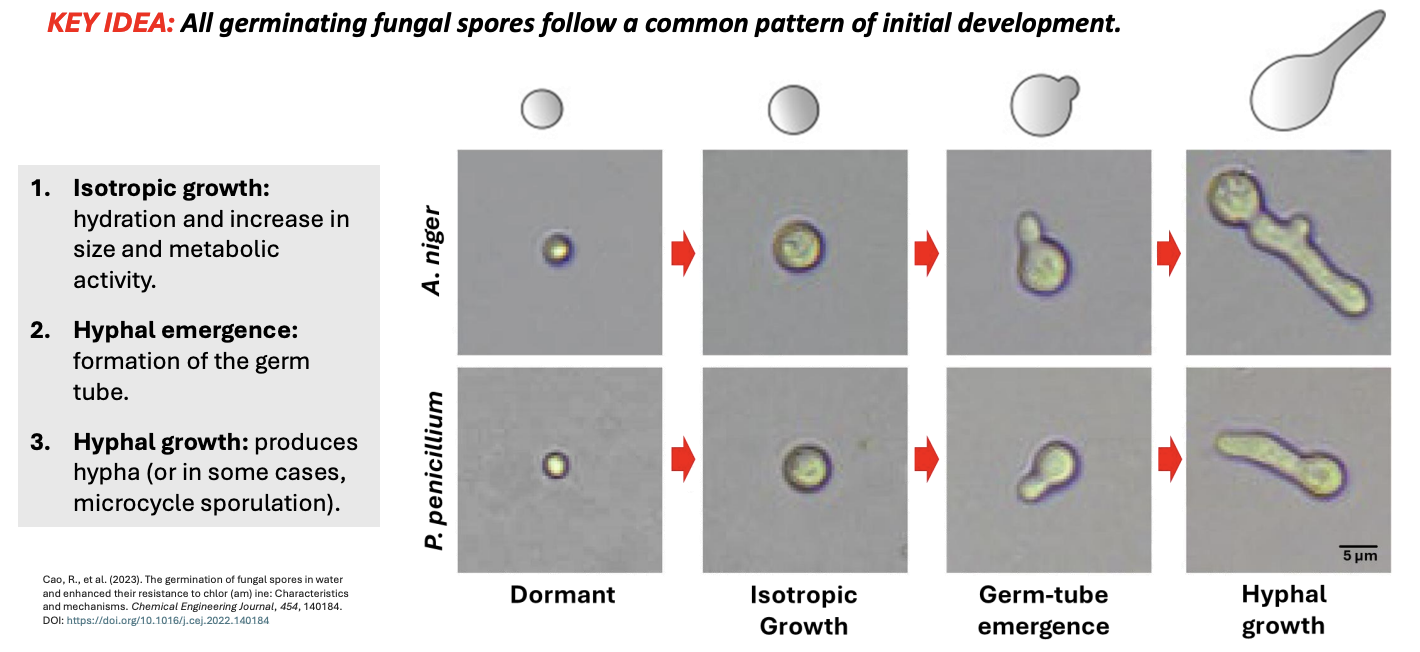
_ are specialized thick-walled spores that develop from hypha during nutrient stress
Chlamydospores
_ can be triggered by many factors reflecting ecology of fungus
Constitutive dormancy
Constitutive dormancy has been linked to several factors, including _, but is poorly understood
(what triggers spore activation from c dormancy) phar
Post-maturation: CW dissolution, thinning
Heat, cold, chemical exposure
Ability to utilize enzymes to metabolize energy reserves, e.g., trehalase
Removal of inhibitors after dispersal
T/F: In very rare cases, plant host metabolites can trigger germination of sexual spores
FALSE
In very rare cases, plant host metabolites can trigger germination of asexual spores

The ecological significance of constitutive dormancy is that, often, _
Enumerate 3 common types of triggers for activation from constitutive dormancy
Triggers for germination is dependent upon reproductive or dispersal behavior of fungal spore
3 triggers for activation
Coprophilous = triggered by acidic environment
e.g., Bolbitius is activated in lab by treatment at 37 C in acidic conditions, simulating gut envi
Thermophilic = triggered by heating or warm ash
e.g., Neurosporea is triggered by temp at 60 C or above; dormancy is due to inability to utilize enzymes for metabolizing trehalose
Association = triggered by compounds released when close to parent hyphae
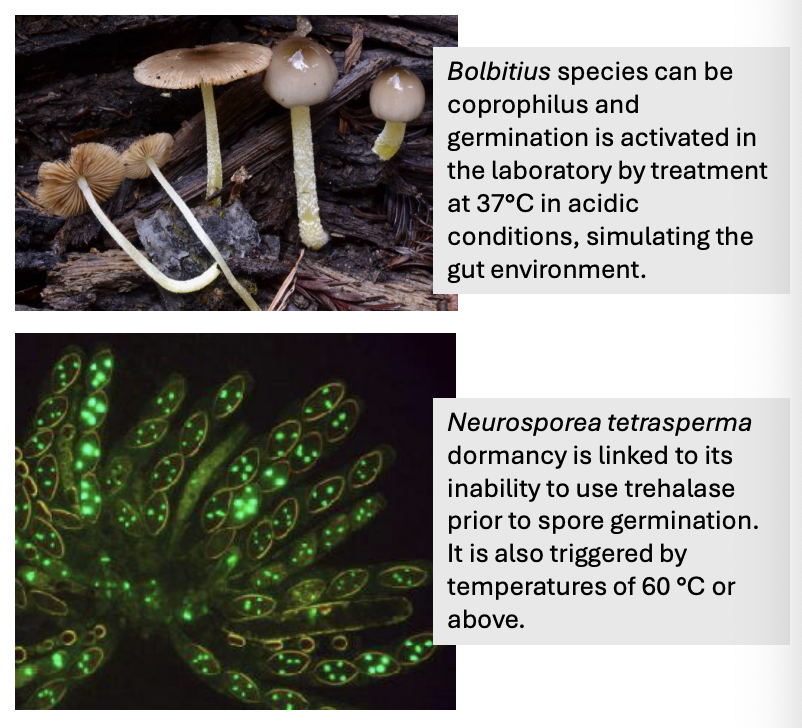
_ ends fungistasis in dormant asexual spores
Availability of nutrients
Asexual spores can be held in suppressed state of dormancy called _ in natural habitats
Fungistasis or mycostasis
_ is a microbially induced suppression of spore germination caused by nutrient competition or microbial metabolites or both but not by antibiotics or inhibitors from other microbes
Fungistasis or Mycostasis
2 causes of mycostasis
Nutrient competition
Microbial metabolites (produced by competitors)
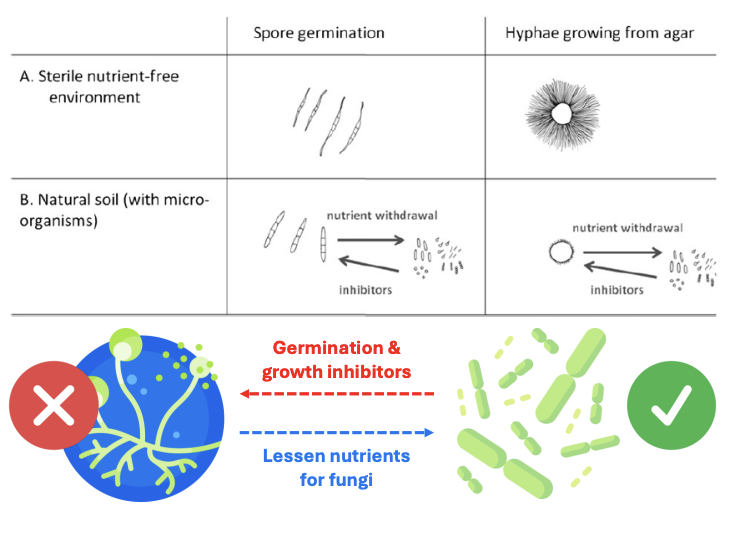
In natural soil, microbial activity contributes to spore dormancy by _
depleting nutrients and producing growth inhibitors
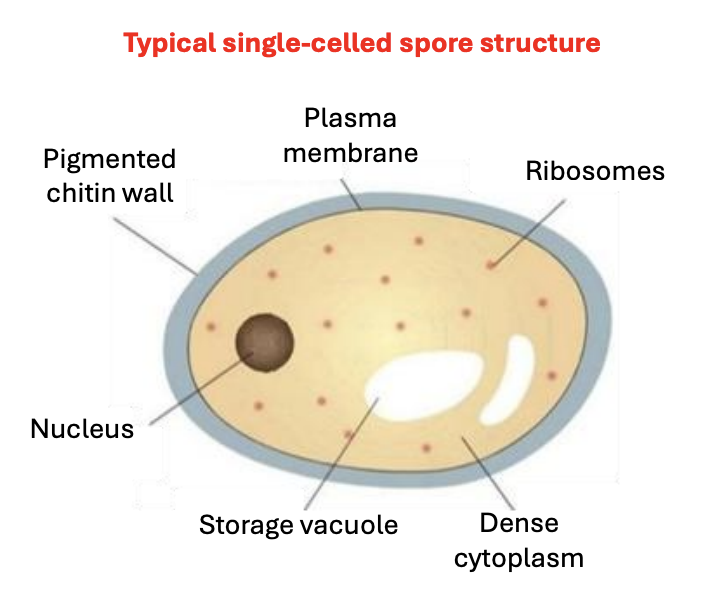
T/F: Fungal spores differ from average somatic fungal cell such that asexual spores are diploid
FALSE
Fungal spores differ from average somatic fungal cell such that asexual spores are haploid
Fungistasis causes spores to remain quiescent in soil or natural habitats until _
Nutrients become available or
Other microbes decline
In very rare cases, _ can trigger germination of asexual spores
plant host metabolites
Explain recent evidence of host-specific triggering of germination in asexual spores (exogenously-imposed dormancy)
In very rare case, there is evidence of host-specific triggering of germination
Sclerotia of Sclerotium cepivorum (which cases economically important “white rot” disease in onions and garlic) have volatile chemical germination triggers
So what happens is,
Onions release nonvolatile sulfur compounds
But, soil bacteria converts these nonvolatile S compounds into volatile compounds
Volatile compounds then trigger the germination of Sclerotium cepivorum, leading to “white rot” disease
(exogenously-imposed dormancy)
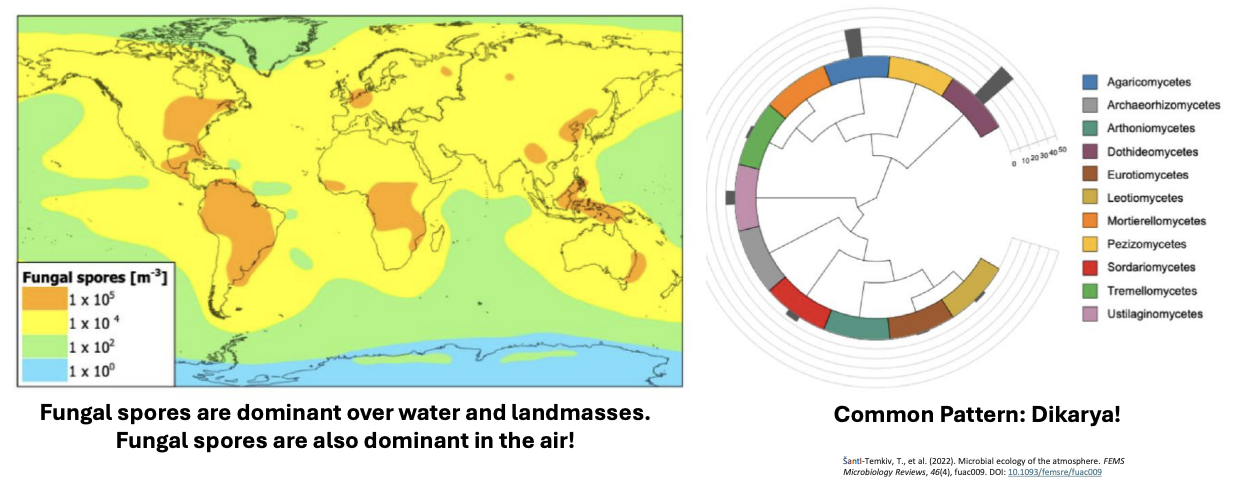
T/F: Fungal spore diversity over the Earth is massive regardless of the geographical location
TRUE
Fungal spores are dominant over _
water, landmasses, and even air
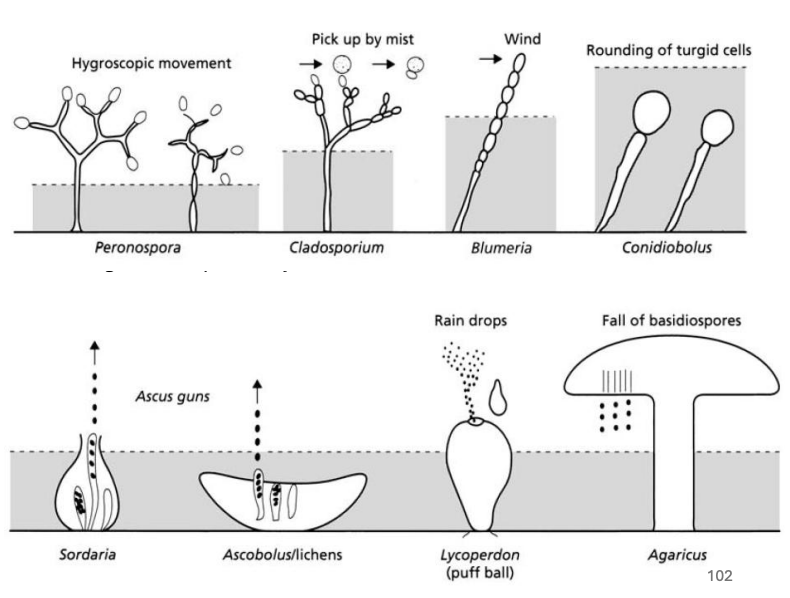
Most fungal spores produce _ that are dispersed by wind over small or large areas
airborne spores
Fungal spore diversity is often due to components for air dispersal, including those for _
Takeoff: how to get airborne and break boundary layer of air
Flight: how to remain airborne; resistance to desiccation (hydrophobins), protection from UV (pigments)
Landing: deposition for future development; siw sedimentation, impaction, washout
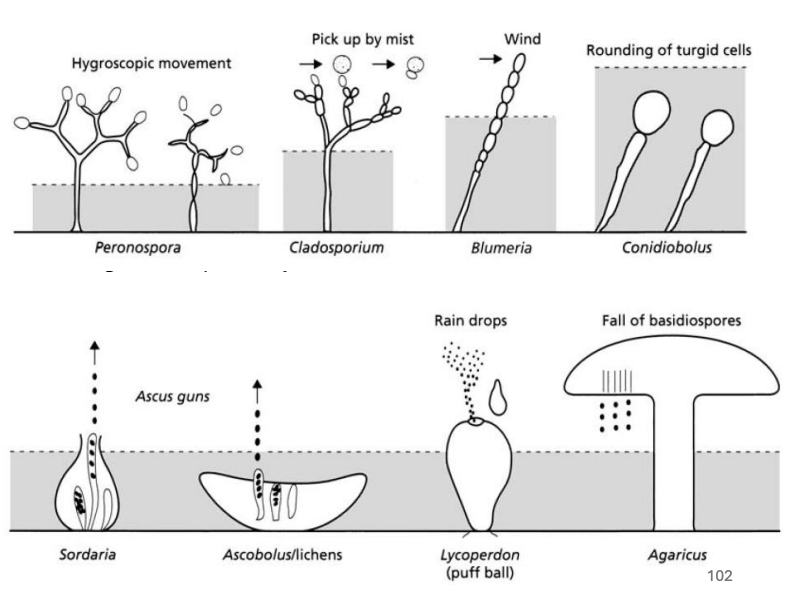
_ ensure that spores are dispersed at a distance from their origin structures
Ballistic propulsion methods
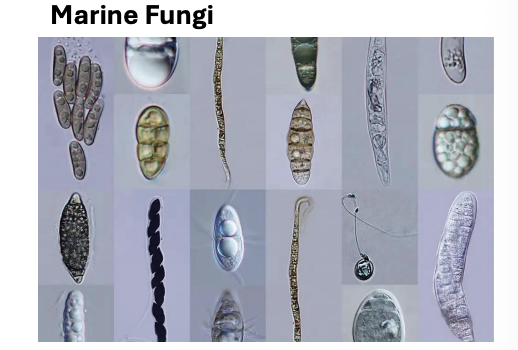
Marine fungi have _ to colonize surfaces
mucilaginous appendages
Explain structure of Pilobolus and its adaptations
Structure
Sporangial stalk = moves to adjust to direction of light
Transparent vesicle = source of explosive force to eject sporangium, sensitive positioning mechanism that responds to light
Sporangium containing spores
Adaptations pel
Phototropism = spore-bearing structures only shoot spores where light can pass (so spores can be shot away)
Explosive discharge mechanism = to shoot spores or spore-bearing structure away
Large projectile = based on ballistic principle, large/heavy objects will travel farther than smaller objects when launched at same initial velocity
Most groups of fungi inhabiting aquatic environment have _
appendaged spores
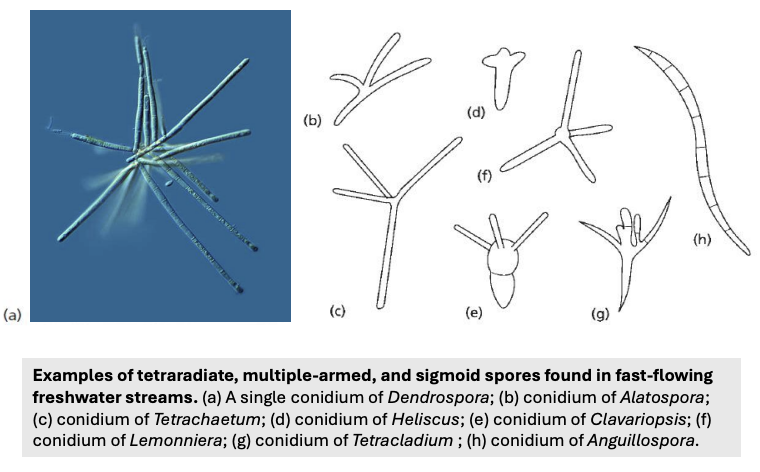
Fungi living in aquatic habitats have spores with _
unusual shapes and conspicuous appendages
Although structurally similar, spores of marine fungi may serve different functions, including _
isec
Increase surface area for nutrient absorption
Sedimentation and anchorage
Entrapment of bubbles for flotation
Catch raindrops for dispersal
T/F: Aquatic fungi have mucilaginous appendages to colonize surfaces
FALSE
Marine fungi have mucilaginous appendages to colonize surfaces
Some fungi use _ to get airborne, examples of which
Water splashes
Splash of wet spores
Puff of dry spores
Tap effect of hail
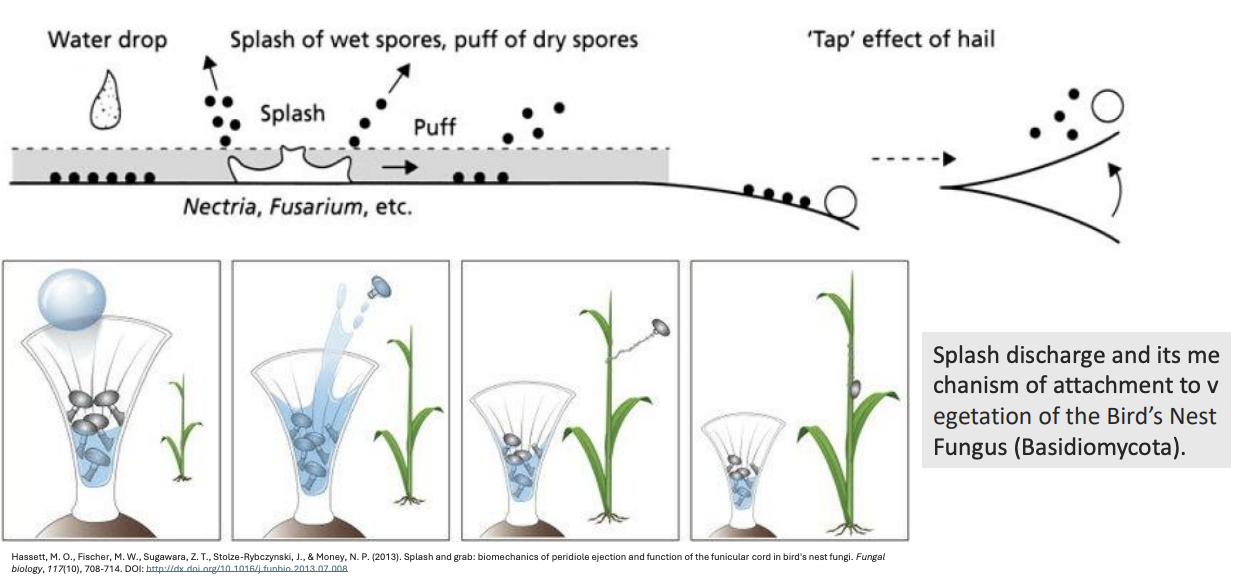
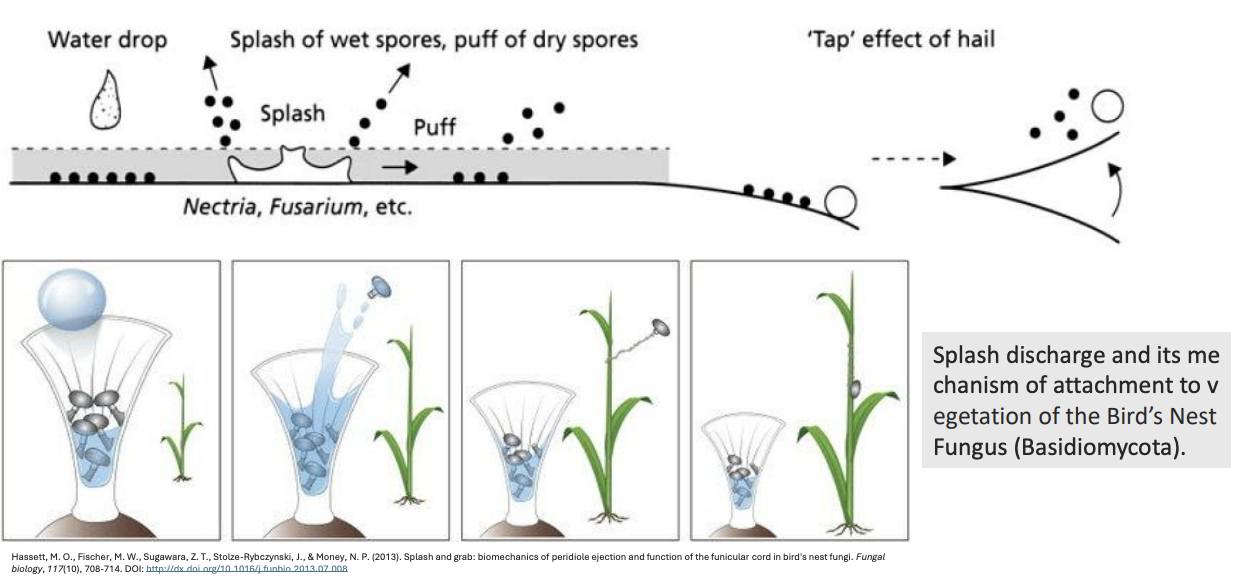
Explain figure shown
Splash discharge and its mechanism of attachment to vegetation of Bird’s Nest Fungus (Basidiomycota)
When water droplet hits petiole, spores are lodged out and in the vicinity, they can release flagella-like structure that allows them to latch onto plants
BUT they need water droplets first to get airborne
Enumerate examples of spore dispersal mechanisms
Wind
Ballistic propulsion
Water (mucilaginous appendages)
Water + Wind (splash discharge)
Animals
Zoospores
T/F: Spores produced associated with mucilage allow them to hitch a ride on insects
TRUE
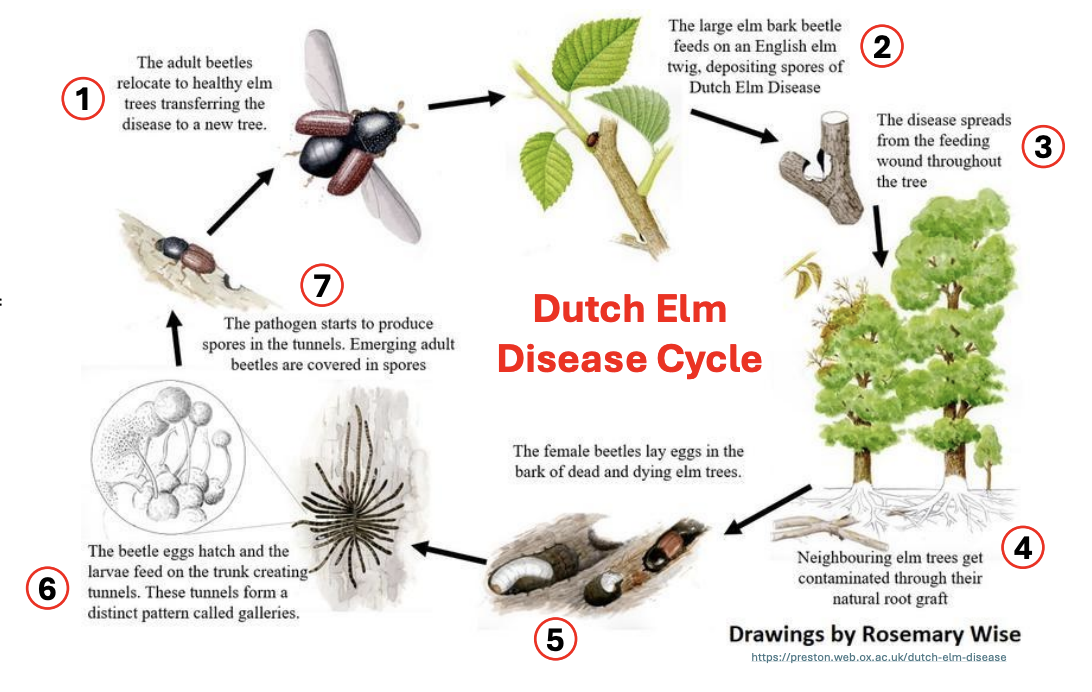
Explain spore dispersal via animals
Insects and small arthropods can disperse several types of fungi and their spores
Mucilage production (in fungi) that enables sticking of fungal structures
Fungi takes advantage of searching behavior of vector to reach a new site
These interactions can be incidental or can become highly evolved mutualisms, as in the case of Dutch Elm Disease caused by Opisthioma ulmi and O. novo-ulmi (Ascomycota)
_ enables sticking of fungal structures
Mucilage production in fungi
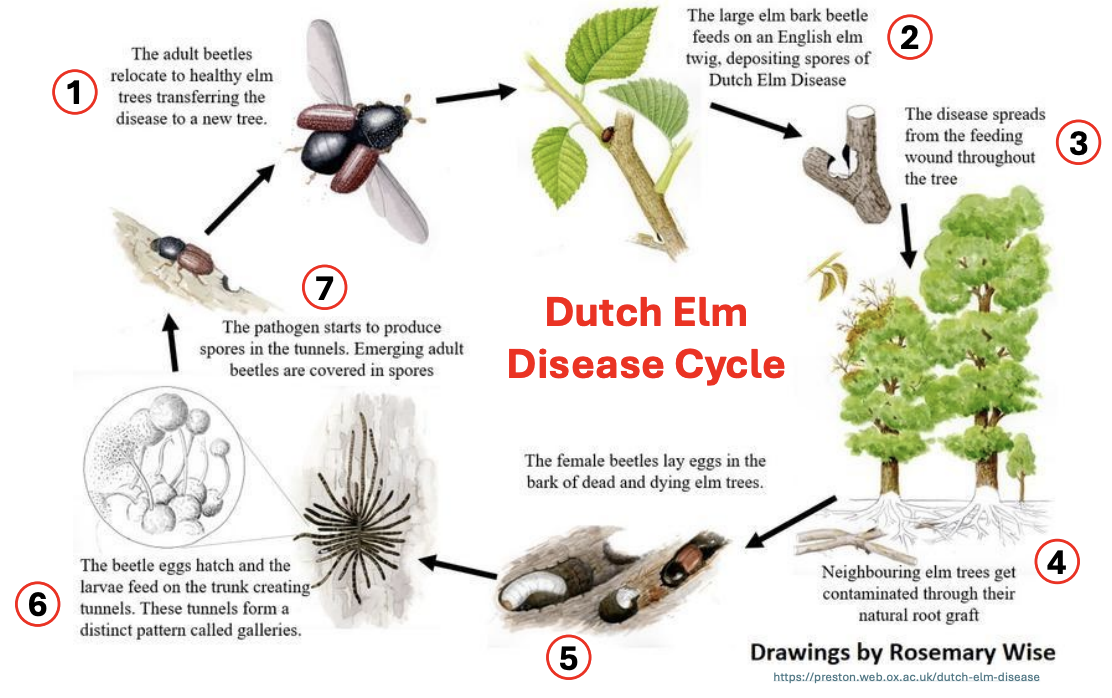
Explain Dutch Elm Disease Cycle arising from fungal spores being dispersed via animals
Adult beetle relocates to a healthy elm tree, transferring disease to that new tree
Large elm bark beetle then feeds on English elm twig, depositing spores of Dutch Elm Disease
Disease spreads from the feeding wound throughout the tree
Neighboring elm trees become contaminated through natural root graft
Female beetle lays its eggs in the bark of dead and dying elm trees
Beetle eggs hatch and larvae feeds on trunk, creating tunnels with distinct patterns called galleries
Fungal pathogen then starts to produce spores in the tunnel galleries, causing emerging adult beetle to be covered in fungal spores, such that
Fungal spores will be dispersed by the beetle once it emerges from the bark and relocates into a new elm tree, repeating the cycle
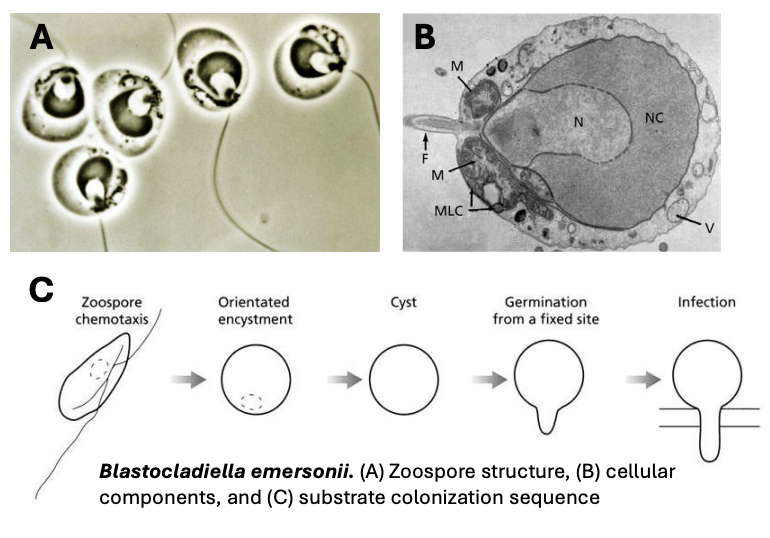
Zoospores can use _ for dispersal
flagellar or amoeboid movement
_ are the only group of Fungi with zoospores
Chytridiomycota
_ refers to the release of vesicle contents for attachment to a surface or a host
Encystment
_ are motile, wall-less cells that swim via flagella using endogenous reserves
Zoospores
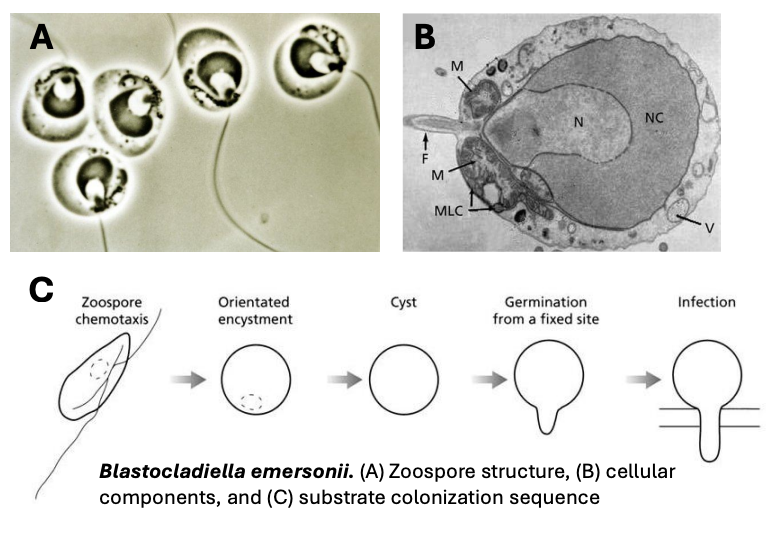
Zoospores have sensory perception, evidenced by _
presence of receptors on their cell surface, allowing them to locate sites of encystment (release of vesicle contents to attach to surface/host)
_ refers to the pattern of recognizing a substrate/host and triggering germination
Homing and docking sequence (of zoospores)
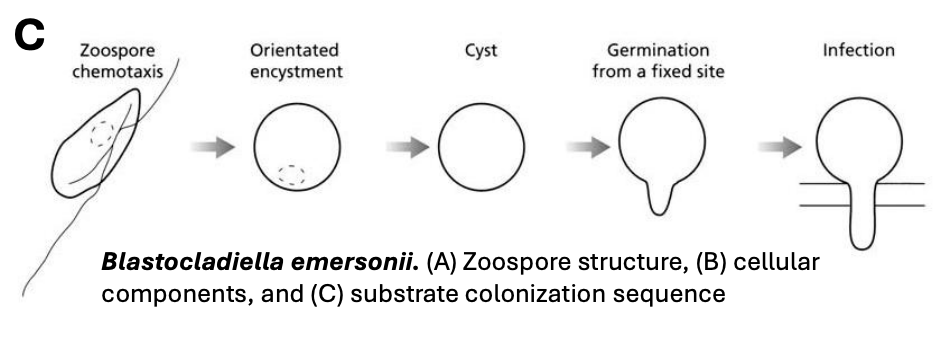
Explain homing and docking sequence in zoospores
Zoospore chemotaxis (to locate sites of encystment)
Oriented encystment
When zoospore positions itself properly on host/substrate, shedding its flagella, growing
Cyst (spore without tail but with vesicles mobilized and stuck to substrate)
Germination from a fixed site
Infection via germ tube/hyphal structure/infection peg
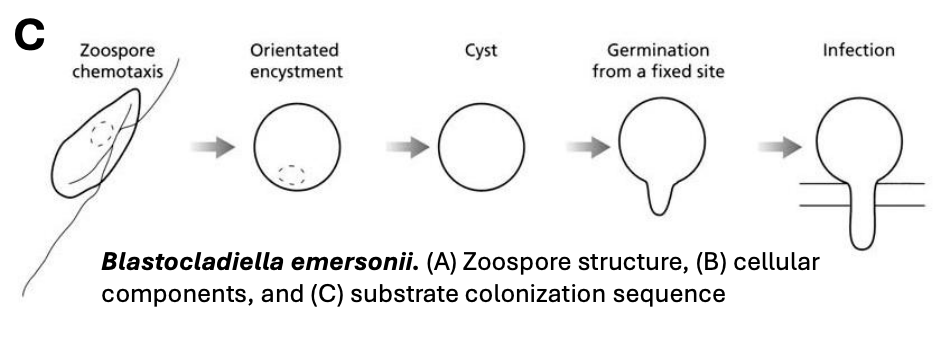
_ movement is present in some Chytridiomycota; can alternate with swimming
Amoeboid (of zoospores)
T/F: Fungal spores will have differences from average somatic fungal cell
TRUE
Most unique dispersal strategy
Zoospores because the spores can swim (feature no longer existing in Modern Fungi)